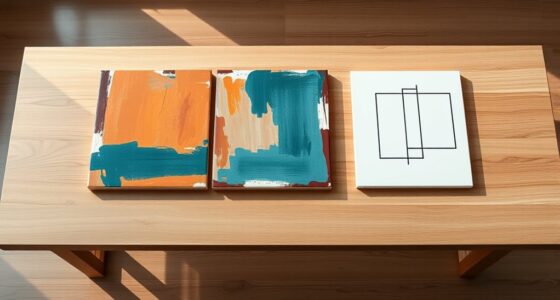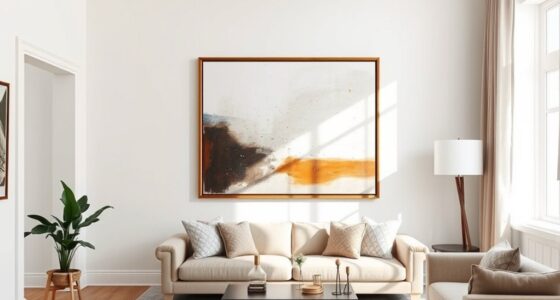To make small spaces feel larger, use scale tricks like opting for oversized artwork to create bold focal points or hanging tall, vertical pieces to emphasize height. Group smaller pieces cohesively or choose sleek, narrow frames to minimize gaps. Playing with proportion and strategic placement guides the eye and adds depth. Thoughtful lighting and minimal decor enhance the effect. Keep exploring for more tips on transforming your space effortlessly.
Key Takeaways
- Use oversized artwork to create a sense of expanded space and serve as bold focal points.
- Incorporate tall, vertical pieces to draw the eye upward, enhancing perceived height.
- Pair large art with minimal surrounding decor to prevent visual clutter and maintain openness.
- Hang artwork at eye level or just below the ceiling to maximize vertical impact.
- Select impactful, simple designs that contrast with the room’s scale for maximum visual impact.
Choosing the Right Frame Size for Small Walls
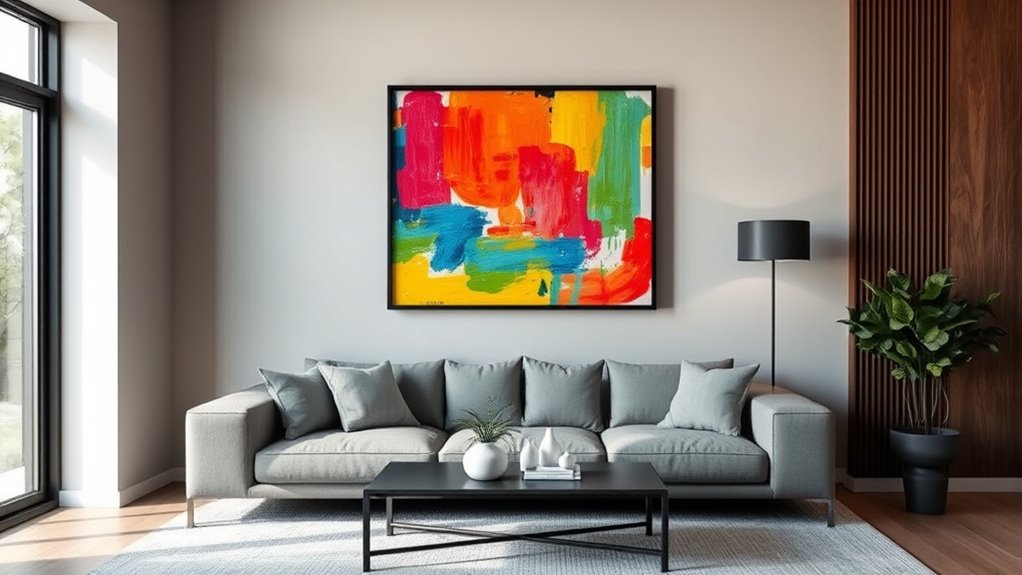
When decorating small walls, selecting the right frame size is essential to create a balanced and appealing look. First, measure your wall to understand its dimensions and visual weight. A frame that’s too large can overwhelm the space, while a small one might look insignificant. Consider the wall measurement carefully—aim for a frame size that complements the available space without crowding it. For small walls, opt for medium-sized frames that suit the overall room scale. You can also use multiple smaller frames grouped together to create a cohesive display. Keep in mind that the goal is harmony; the frame size should enhance your artwork without overpowering or getting lost in the wall. Proper sizing ensures your art becomes a focal point instead of an afterthought.
Creating the Illusion of Space With Large Artwork
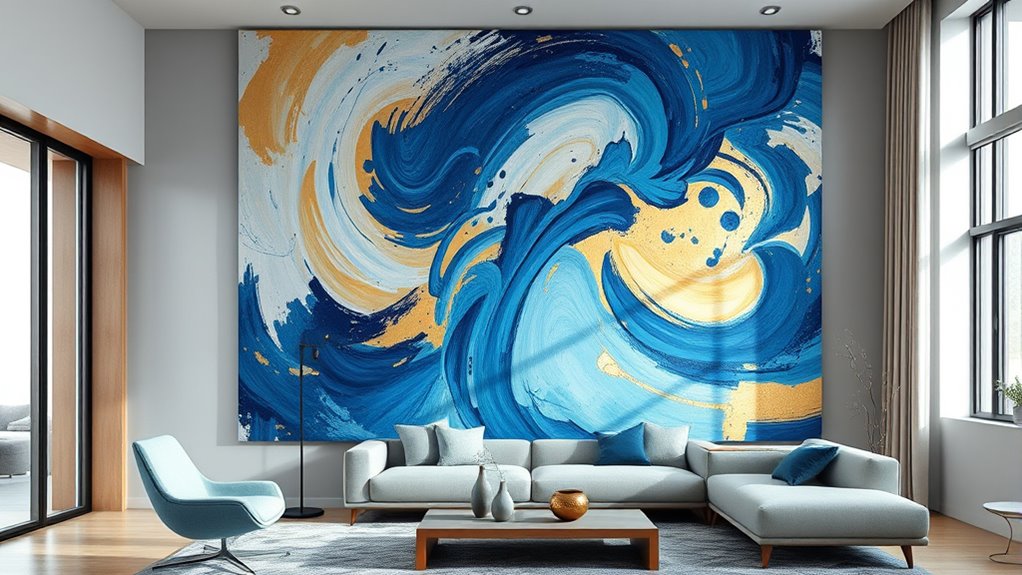
Using oversized artwork can make your small space feel much larger by expanding the visual area. Placing these pieces strategically guarantees they have maximum impact without overwhelming the room. Keep decor minimal around the artwork to highlight its presence and create a sense of openness. Incorporating large-scale artwork can also influence the perception of contrast ratios and color depth, enhancing the overall visual harmony of your space. Understanding how visual perception works can help in choosing the right pieces to maximize the illusion of space. Additionally, selecting artwork with light colors can further amplify the feeling of openness and airiness in confined areas. Being aware of Louisiana alimony laws and how they impact legal decisions can also guide you in creating a balanced and harmonious environment that reflects your personal space.
Oversized Pieces Expand Visual
Large artwork can dramatically transform a small space by creating the illusion of openness and depth. To maximize this effect, focus on three key points:
- Use artistic contrast by pairing bold, oversized pieces with simpler surroundings to make the artwork stand out and draw the eye inward.
- Guarantee color coordination by selecting large pieces with hues that complement your room’s palette, making the space feel cohesive and less cramped.
- Hang the artwork at eye level and let it dominate your wall, which emphasizes scale and gives the impression of a larger area.
Strategic Placement Maximizes Impact
Strategic placement of your artwork can considerably enhance the sense of space in a small room. To create the illusion of larger space, choose bold, cohesive color schemes that draw the eye upward or across the room. Incorporate lighting techniques such as wall washers or spotlights to highlight your artwork and add depth, making the space feel more expansive. Hang large pieces at eye level to establish a visual focal point, which guides the eye smoothly across the room. Position artwork near natural light sources to amplify brightness and openness. Avoid cluttering walls with multiple small pieces; instead, let one carefully placed large artwork dominate the space. Proper placement, combined with thoughtful color choices and lighting, transforms your small room into a more open, inviting area. Additionally, understanding how visual perception influences our sense of space can help you select artwork and decor that enhance the feeling of openness, especially when considering the use of scale tricks to manipulate perceived room size. Recognizing the cultural significance of butter in art and tradition can inspire unique choices in your decor, adding layers of meaning to your space.
Minimal Decor Highlights Artwork
When you keep decor minimal, your artwork becomes the main focus, making the space feel larger and more open. To enhance this effect: 1. Choose a neutral or monochrome color scheme to prevent visual clutter and let the artwork stand out. 2. Use strategic lighting techniques, like wall-mounted spotlights or soft ambient lighting, to highlight the piece and add depth. 3. Opt for large, bold artwork that commands attention without overwhelming the room, creating an illusion of spaciousness. Additionally, incorporating visual balance helps ensure the artwork remains the focal point without disrupting the harmony of the space. Maintaining safety guidelines for wall fixtures can also prevent accidents and keep your display secure. Carefully selecting wall surfaces that are suitable for artwork installation can further improve the overall aesthetic and safety of your display. Emphasizing alternative investments, such as gold, can be a smart way to diversify your portfolio even in small spaces.
Grouping Smaller Pieces for a Cohesive Look

Grouping smaller art pieces can create a striking focal point, even in a compact space. To achieve a cohesive look, focus on frame coordination—using frames that match or complement each other helps unify the display. Consistent framing styles or finishes make the collection feel intentional and polished. Additionally, prioritize color harmony; selecting artwork with similar color palettes or complementary hues ties the pieces together visually. Arrange the pieces in a grid or salon-style layout to maintain order and balance. Keep spacing even to ensure the grouping feels intentional rather than cluttered. Incorporating interior design principles like visual balance can further enhance the overall aesthetic and harmony of your art arrangement. Being aware of store hours can also help you plan shopping trips efficiently when selecting art supplies or framing options. Paying attention to scaling and proportion ensures each piece complements the others without overwhelming the space.
Opting for Vertical Art to Maximize Height
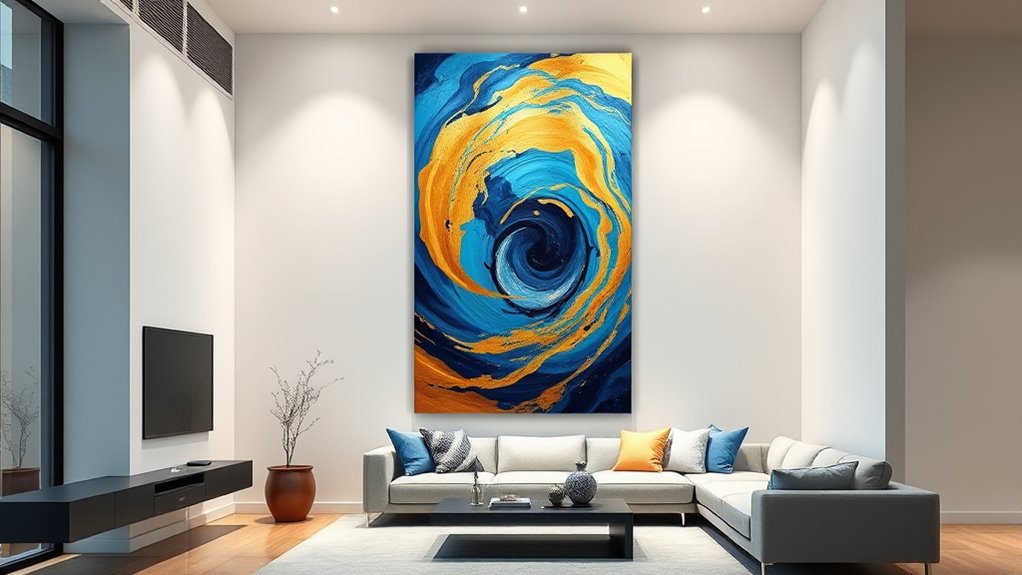
Using vertical art can make your space feel taller and more open. By placing artwork higher on the wall, you draw the eye upward and emphasize the room’s height. This simple trick can transform a small area into a more expansive feel. Incorporating scale tricks like this can further enhance the perception of space and balance in your decor. Additionally, choosing artwork with appropriate proportions ensures it complements the room without overwhelming it. Exploring best beaches for inspiration can also offer ideas on how to create a refreshing and airy atmosphere. Being aware of cybersecurity concerns, such as protecting digital assets, can help you maintain a safe environment for your personal and professional spaces.
Vertical Art Placement
Have you considered how vertical art can dramatically enhance small spaces? Placing tall, narrow pieces draws the eye upward, emphasizing height. To maximize impact, focus on these key points:
- Color coordination: Choose artwork with colors that complement your wall and furniture, creating a seamless flow that elongates the space.
- Lighting enhancement: Use targeted lighting to highlight vertical pieces, making them pop and adding depth to your room.
- Placement tips: Hang art higher than usual—just below the ceiling—to create an illusion of greater height, and align it with other vertical elements for visual harmony.
- Tuning modifications: Incorporating suspension upgrades can also improve the overall feeling of stability and presence within your space, much like how suspension upgrades improve vehicle handling.
This approach not only accentuates your room’s vertical dimension but also boosts overall lighting and color harmony, making your small space feel larger and more inviting.
Enhancing Room Height
To make a small room feel taller, opt for vertical art that draws the eye upward. Choose artistic styles that emphasize height, such as elongated figures or tall landscapes, to create the illusion of expanded space. Framing techniques also play a pivotal role; using tall, narrow frames or extending the frame closer to the artwork’s edges minimizes gaps and accentuates height. Hang your art high on the wall, just below the ceiling, to further elongate the room’s vertical dimension. Combining these strategies helps your space feel more open and airy. Remember, the goal is to direct attention upward, so select artworks and framing methods that reinforce this effect. With intentional choices, you can maximize room height and create a more spacious feel.
Balancing Scale With Surrounding Furniture
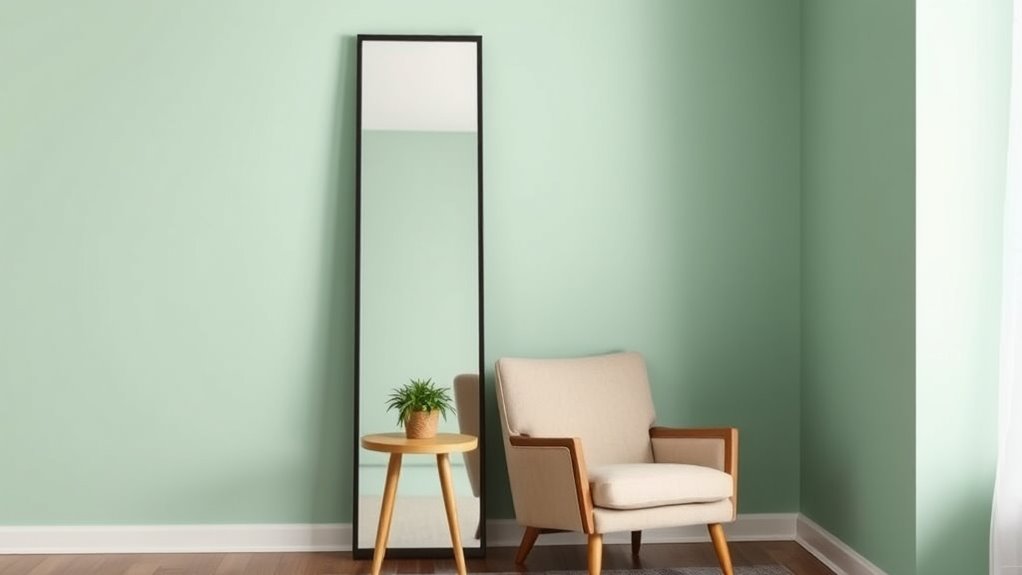
When arranging art in small spaces, it’s vital to think about how its size relates to the surrounding furniture. Proper balance prevents overwhelming or underwhelming your room. To achieve this:
- Choose artwork that complements the scale of nearby furniture, avoiding pieces that are too large or small.
- Use color coordination to tie the art to your existing palette, creating harmony and visual flow.
- Enhance lighting around the art to draw focus and add depth, making the piece feel integrated rather than isolated.
- Be mindful of vetted privacy and cookie policies when browsing online art sources to protect your personal information.
- Consider remote hackathons or virtual art exhibitions to discover new inspiration and connect with artists worldwide.
- Incorporating AI-powered virtual reality in e-learning tools can also help visualize how different art pieces will look in your space before making a purchase.
- Understanding security measures in online platforms ensures your transactions are safe and your privacy is maintained.
Using Mirrors to Enhance Art and Space
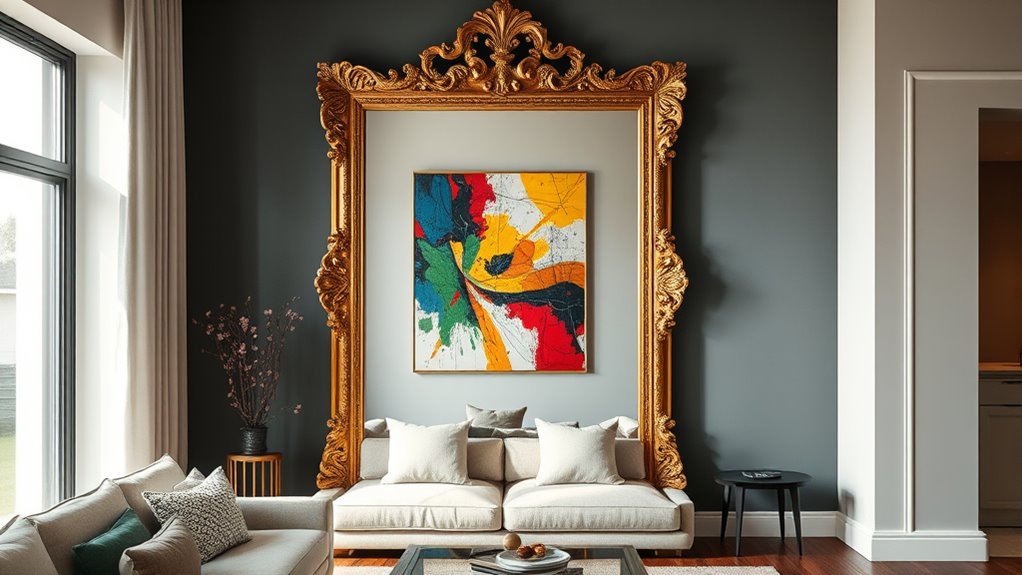
Mirrors can be powerful tools for amplifying the impact of your artwork and making small spaces feel larger. By strategically placing mirrors, you create the illusion of depth, reflecting light and opening up the room. Experiment with lighting effects by positioning mirrors where natural or artificial light hits them, enhancing brightness and highlighting your art. Consider color coordination—frames and surrounding decor that match or complement your artwork will create a cohesive look, making the space feel intentional and balanced. Larger mirrors can serve as focal points, while smaller ones scattered thoughtfully can add visual interest without cluttering. Overall, mirrors not only boost the sense of space but also elevate your art display, making your small room feel more open and curated.
Making a Statement With a Single Oversized Piece
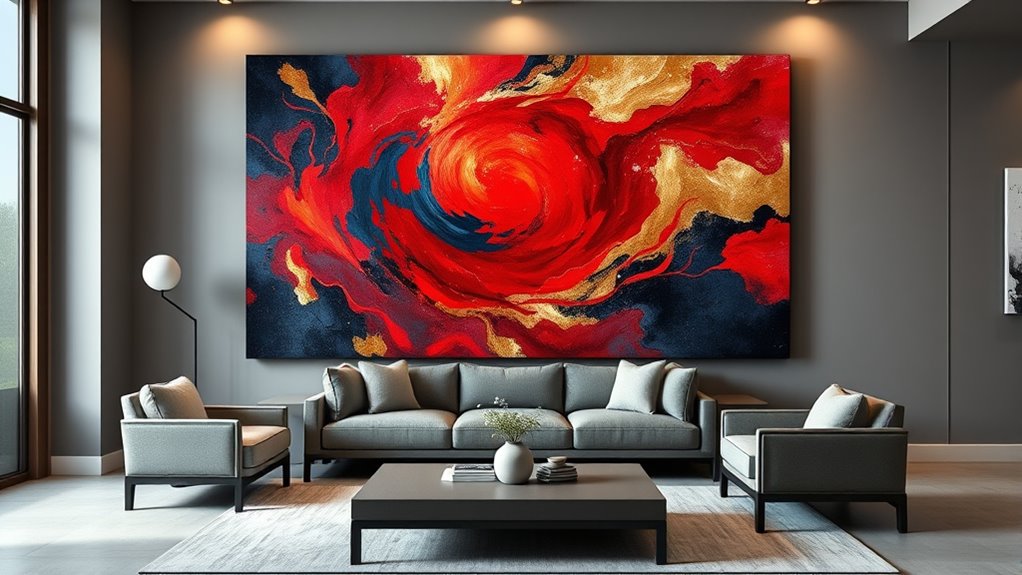
A single oversized art piece can transform a small space into a striking focal point that commands attention. To maximize its impact, focus on:
- Color coordination: Choose artwork with hues that complement your room’s palette, creating harmony and visual interest.
- Lighting enhancement: Use targeted lighting—like picture lights or spotlights—to highlight the piece and add depth.
- Placement: Hang the art at eye level and centered on the wall to draw focus directly to it, avoiding clutter around it.
Playing With Proportion in Gallery Walls

To create a dynamic gallery wall, you can experiment with varying frame sizes to add visual interest. Grouping artwork by theme helps maintain cohesion, while balancing visual weight prevents the display from feeling chaotic. Play with these elements to craft a proportional arrangement that enhances your small space.
Varying Frame Sizes
Varying frame sizes can add visual interest and energy to your gallery wall by playing with proportion. By mixing different frame proportions, you create a dynamic look that keeps the eye moving. Consider these tips:
- Use larger frames with bold art size as focal points, then surround them with smaller frames to balance the composition.
- Combine narrow, tall frames with wider, shorter ones to add variety and movement.
- Mix frame styles and sizes within the same color palette to unify the display while keeping it lively.
This approach allows you to experiment with different art sizes and frame proportions, making your small space feel more curated and intentional. Varying frame sizes keeps your gallery wall fresh and engaging.
Grouping by Theme
Grouping artwork by theme creates a cohesive look that enhances the visual rhythm of your gallery wall. When you select pieces with complementary color harmony, your display feels unified and intentional. Consider choosing artworks that share a common palette or mood, which guides the eye smoothly across the arrangement. Incorporate texture contrast by mixing smooth, glossy surfaces with rough or tactile materials; this adds depth and interest without disrupting harmony. By focusing on a central theme—such as nature, abstract shapes, or monochrome tones—you create a visual narrative that feels balanced and engaging. This approach helps small spaces feel curated and purposeful, ensuring each piece supports the overall story while playing with proportion to emphasize key works.
Balancing Visual Weight
Balancing visual weight is essential for creating a harmonious gallery wall, especially in small spaces where every piece counts. To achieve this, consider these strategies:
- Use color coordination to distribute visual interest evenly; balance bold hues with neutral tones to prevent any one piece from overwhelming the wall.
- Play with lighting enhancement by highlighting larger or more vibrant artworks, guiding the eye smoothly across the display.
- Vary the size and scale of your art pieces to create a sense of proportion, ensuring no single element dominates the arrangement.
Selecting Art With Bold, Impactful Designs
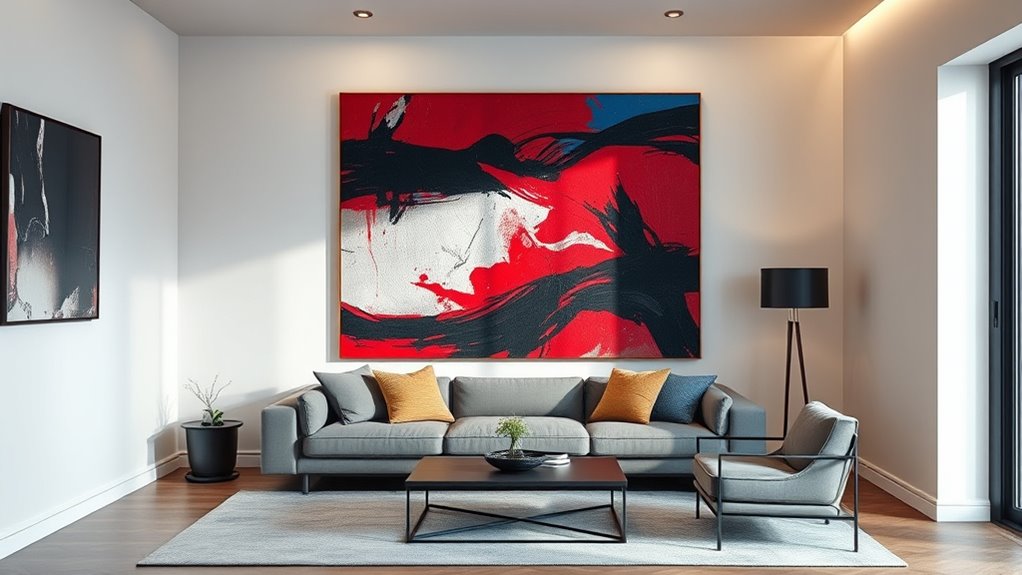
When choosing art with bold, impactful designs for small spaces, it is essential to focus on pieces that immediately draw the eye and create a strong visual statement. Look for artwork featuring abstract shapes that add intrigue and modernity. Incorporate bold colors to energize the room and make your space feel vibrant. Bright reds, deep blues, or striking blacks can serve as focal points without overwhelming the area. Keep in mind that simplicity in design often packs a punch; avoid overly busy images that clutter your small space. Instead, select pieces that use strong contrasts and dynamic compositions. These impactful artworks will command attention and add personality, making even the tiniest room feel intentional and lively.
Arranging Art to Guide the Eye and Expand the Room
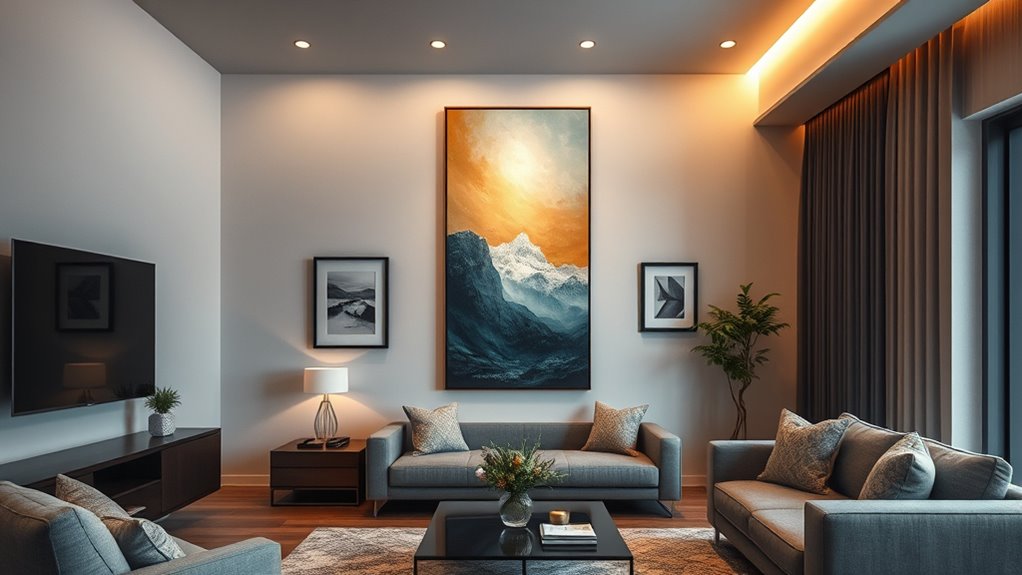
To make small spaces feel larger and more inviting, strategically arranging your art can effectively guide the eye and create a sense of depth. First, position your artwork at eye level to draw attention and establish a visual focal point. Second, use color coordination by selecting art pieces that complement wall colors, which helps unify the space and prevent visual clutter. Third, enhance lighting around your art with targeted lighting or wall sconces; this not only highlights key pieces but also adds depth. Combining these techniques guides the eye naturally around the room, making it appear larger. Proper placement, thoughtful color coordination, and lighting enhancement work together to expand your small space visually and make it feel more open.
Frequently Asked Questions
How Do I Choose Art Colors That Make My Space Appear Larger?
To make your space appear larger, choose art with high color contrast, like black and white or bold hues, which adds depth and visual interest. Opt for monochrome palettes in softer shades to create a seamless, expansive feel. You should also keep the artwork’s colors light and airy, avoiding dark, overwhelming tones. This approach tricks the eye into perceiving more space, making your small room feel open and inviting.
What Lighting Techniques Best Highlight Small Art Pieces?
You should use gallery lighting with spotlights to highlight small art pieces effectively. Focus the spotlights directly on the artwork to create a focal point and enhance details. Keep the lighting adjustable so you can control brightness and shadow, ensuring the art stands out without overwhelming the space. Using multiple spotlights or wall-mounted gallery lighting can add depth and make your small art pieces truly pop.
How Can I Incorporate Art Into Oddly Shaped or Irregular Walls?
You can incorporate art into oddly shaped or irregular walls by using wall adhesives for seamless mounting and choosing modular displays to adapt to unique wall contours. These options let you customize your arrangement, filling uneven spaces creatively. Opt for a mix of small, varied pieces or large, statement art to balance the irregularities. This approach transforms challenging walls into eye-catching focal points, making your space feel intentional and stylish.
Are There Specific Framing Styles That Enhance Small Artwork?
Think of framing styles as the frame around a jewel, enhancing its sparkle. For small artwork, sleek, minimalist frames like thin metal or simple wood can make pieces pop without overwhelming. When creating gallery walls, unify pieces with matching frames or a consistent style to create harmony. These choices draw attention to your art, making each piece feel intentional and vibrant, even in tight spaces.
How Do I Prevent Clutter When Displaying Multiple Small Art Pieces?
To prevent clutter, use effective wall mounting strategies like aligning your small art pieces in a grid or salon style for a cohesive look. Grouping techniques, such as spacing artwork evenly or creating visual weight with varied sizes, help balance the display. Keep a consistent frame style and color palette to unify the collection. Regularly step back to assess the arrangement, ensuring it feels organized rather than overwhelming your space.
Conclusion
By choosing the right scale and thoughtfully arranging your art, you transform small spaces into enthralling galleries. Think of your walls as a blank canvas waiting to be filled—each piece a brushstroke of personality. When you master the art of scale, you don’t just decorate; you create an illusion of grandeur. So, embrace these tricks and let your walls speak volumes—after all, great art turns tiny rooms into mighty statements.



